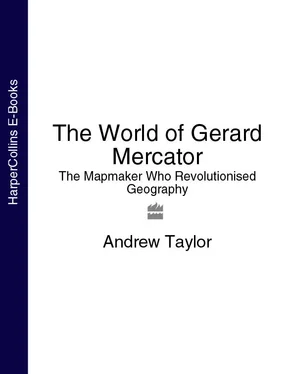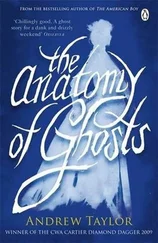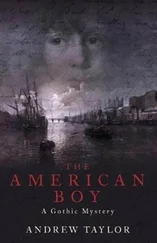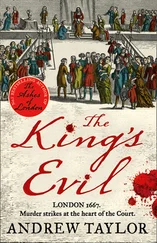IN THE EAST, the scanty records and remains of the work of the Chinese suggest that they had their own impressive tradition. Around the third century AD, a government minister of works named Phei Hsiu set out official principles for the making of maps under the Chin Dynasty. The most important of these was that they should be constructed on a rectangular grid in order to create a consistent scale and locate places accurately. There is no evidence that Ptolemy’s thinking had reached the Far East – a grid system had been introduced in China some two hundred years before Phei Hsiu by Ptolemy’s near-contemporary Chang Heng, an astronomer royal of the Han Dynasty. *He wrote of a spherical world suspended in infinity, like a yolk in an egg, and the system he introduced of building up a map by equal squares – “casting a net over the Earth,” in a contemporary phrase – was the basis of Chinese cartography for centuries.
Chang Heng’s grid made no allowance for the curvature of the Earth, and it is hard to know from what is left of ancient Eastern cartography whether his image of a spherical world had any effect on current thought. There are no indications that early Chinese mapmakers realized the world was a sphere, that the lands they were mapping were consequently curved, nor whether the challenge, which still fascinates cartographers, of representing such a three-dimensional world on a flat surface had even occurred to them as a problem.
In the Islamic world, Arab mapmakers drew on the ideas of Ptolemy and the Greeks to develop their own traditions. By the eighth century, they were compiling maps for overland diplomatic missions to China, military campaigns, and trading expeditions; the tales of Sindbad the Sailor, dating from some two hundred years earlier, are ample evidence of their seafaring traditions. Unlike the work produced by medieval monks in Europe, their maps seem to have been designed for use as much as for study, but they were still based mainly on copies of older European originals. There are early versions of the T-O maps, with south at the top and Mount Sinai in the center and, slightly later, more distinctively Arab interpretations in which a disk-shaped world, surrounded by water, is pierced from the east by the Arabian Gulf and the Red Sea, and from the west by the waters of the Mediterranean.
Later mapmakers of the tenth and eleventh centuries were often slave dealers or traders, making their way north to the shores of the Caspian Sea and up the Volga River deep into the heart of Asia. Asian tribesmen, Russians, Norsemen, and Arabs would meet on one of the medieval world’s great trading routes, exchanging goods, knowledge, and ideas.
One account, by the writer Ibn Haukal, author of The Book of Roads and Kingdoms , which contained a map of the Islamic world as it was then known, described a meeting toward the end of the tenth century with the great Arab cartographer al-Istakhri. “He showed me the geographical maps in his work, and, when I had commented on them, he gave me his work with the words, ‘I can see that you were born under a lucky star, therefore take my work and make such improvements as you think fit.’ I took it, altered it in several particulars, and returned it to him.” 6
There was cooperation not just between individuals but between cultures. One of the greatest of all the Arab cartographers, Muhammed al-Idrisi, was born in Morocco, studied at Cordoba in Islamic Spain, and worked at the twelfth-century court of the Christian king Roger of Sicily. There, he produced several world maps that drew directly both on Ptolemy and on the observations of Arab travelers, and which were still being used as models by Islamic cartographers four hundred years later. Among them were a large rectangular map in seventy sheets, and a smaller, circular map, similar to the T-O maps of the West, but incorporating curved parallels, which suggest that al-Idrisi was aware of the spherical shape of the world. The maps and sources that he used are lost, but the geographic detail he provided was far in advance of anything that was being produced by the copyists in Europe’s monasteries. Al-Idrisi’s representation of Spain, for example, with the northern coast of Africa, the Straits of Gibraltar, and Bay of Biscay all clearly discernible, is far more detailed than the stylized version presented around the same time by European mapmakers. When Al-Idrisi described Britain as “a great island, shaped like the head of an ostrich,” and the peninsula of Cornwall as “like a bird’s beak,” 7he had evidently been studying more accurate maps than anything available in Europe.
DESPITE ITS ULTIMATE INFLUENCE in Europe, for hundreds of years after publication of the Geographia , Christian scholars turned their backs on Ptolemy’s knowledge. With the fall of the Roman Empire, the original manuscripts that Ptolemy had written in the second century were lost and forgotten. For the medieval scribes of the early Church, the old T-O maps compiled in the centuries before Ptolemy had the great advantage that they could easily be adapted to place the holy city of Jerusalem at the center of the world, as the Bible itself decreed. 8For them, as for the Greek philosophers, the sea was a fitting symbol to represent the mysteries that bounded man’s little area of knowledge on every side. What had not been established by exploration was supplied by imagination or faith; the maps that the medieval Christian scholars drew were therefore inaccurate, impressionistic expressions of belief, not descriptions of fact.
Some of these great mappaemundi, the medieval pictures of the world, were also works of art of staggering beauty. Most of them are lost, but in the English cathedral city of Hereford, it is still possible to glimpse the vision of the world that was in men’s minds on the eve of the age of discoveries. The great Hereford mappamundi dates from the last years of the thirteenth century. 9Even after a visitor to the cathedral has puzzled out the fact that, as on almost all early maps, east is to the top, and has spotted the outline of the Mediterranean Sea that divides the world down the middle, the coastlines and landforms are almost unrecognizable. There is no mistaking the traditional T -shape of great waters surrounded by the O of the ocean, although the lands are threaded with rivers. The British Isles clutch grimly to the perimeter of Europe, twisted and misshapen; instead of the familiar boot shape of Italy, there is a bloated peninsula, dotted with apparenty random cities and ribbed with unknown rivers. The names of Europe and Africa are transposed, probably a mistake by the copyist. Indeed, the map as a whole seems to be sketched more in hope than in conviction. Any modern classroom could produce a dozen more realistic views of the world. Ptolemy would have scoffed.
Yet the Hereford mappamundi has its own confidence, as befits the only complete wall map of the world known to have survived from the Middle Ages. It speaks the language of another age. What were once its bright colors are faded and browned into a dull ochre that challenges the eyes, while the drawings that crowd the map seem almost to jostle each other aside; it takes a while to focus on them individually, to see the delicacy and precision with which they are sketched in. Carefully drawn towers and turrets mark some of the cities of which the map-maker had heard: The familiar names of the Bible are clustered around Jerusalem, and, closer to home, Paris, Ghent, and even Hereford itself are marked. But it is a work to be interpreted, rather than simply consulted; a statement of belief.
Medieval library catalogs show that there were few monasteries or noble palaces without such maps in their stores of manuscripts. Charlemagne, at the end of the eighth century, had plans of Rome and Constantinople engraved on silver tablets among a comprehensive collection, and most great libraries would have included maps of the Holy Land as well as the great mappaemundi – triumphs and baubles for the rich and mighty, and reminders for the humble poor of their place in the great scheme of being. Few survived. A sister-map of the Hereford mappamundi, the Ebsdorf map, was rediscovered in a Benedictine monastery in the German town whose name it bears after being lost for six hundred years, only to be destroyed by Allied bombing during World War II. Now it survives only in modern copies and photographs. The history of cartography is the tantalizing study of what has been left behind.
Читать дальше












